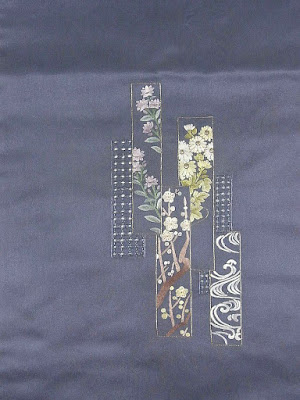Japan has traditionally prided itself on its awareness of the four seasons and the fleeting nature of each one. Special foods, events, and even motifs in kimono all reflect their particular time of year and would seem out of place in another, like Christmas decorations seen in March.
This allows a kimono wearer to become, in a way, part of the fleeting essence of the season or to "anticipate" coming changes in a season. For example, wearing an uchiwa (round fan) obi would help create a nice summer outfit, showing harmony between the wearer and the season.
Part of the fun of owning a piece with a seasonal motif is looking forward to the short time you can wear it.
That said, following the change of the seasons in kimono can get tricky, as most of us kimono wearers don't have the budget to outfit ourselves for each specific part of each season! However, there are two ways around this issue.
The first is the use of abstract motifs that have no associated season, like kikko (tortoise shell) or shippo (interlocking circles).
The second budget-friendly choice is to buy items that are pan-seasonal. These items will have different motifs from different seasons mixed together, canceling each other out and making the item OK to be worn during more than one season or year-round.
The Nagoya obi I just bought from online seller Ichiroya is a good example. You can see the ume (plum blossoms) of winter or early spring, the waves of winter, the kiku (chrysanthemums) of fall, and the kikyo (bellflower) of fall, which means I can properly wear this obi during fall, winter, and early spring.
A big thank you to the forum members at Immortal Geisha for helping me sort this one out! To give a quick review, Ichiroya was honest in their description of the item, shipped it very quickly and nicely packaged, and maintained good communication in English throughout the process. :)
(All images copyright Ichiroya and used with permission.)
Sunday, February 26, 2012
Sunday, February 5, 2012
Ghost Tales with Hyakumonogatari Kaidankai
If I'm "The Kimono Lady", Zack Davisson is most definitely several ranks higher than me, probably "The Ghost King"!
Zack runs an excellent blog called Hyakumonogatari Kaidankai, dedicated to his own translations and posts about Japanese ghosts, monsters, and weird tales in traditional folklore.
Zack, who wrote his Japanese Studies master's thesis on ghost tales, effortlessly manages the difficult balancing act of writing entries that are both packed with detailed information and written in an engaging, casual style that's friendly to both knowledgeable readers and those new to Japanese history and folklore.
If you haven't run across his blog yet, stop by and take a look. :)
Zack runs an excellent blog called Hyakumonogatari Kaidankai, dedicated to his own translations and posts about Japanese ghosts, monsters, and weird tales in traditional folklore.
Zack, who wrote his Japanese Studies master's thesis on ghost tales, effortlessly manages the difficult balancing act of writing entries that are both packed with detailed information and written in an engaging, casual style that's friendly to both knowledgeable readers and those new to Japanese history and folklore.
If you haven't run across his blog yet, stop by and take a look. :)
Subscribe to:
Comments (Atom)




